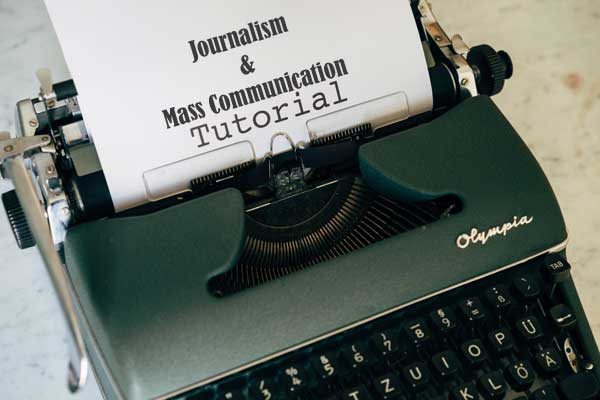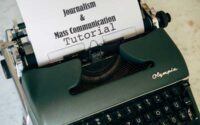Mass Communication Model Papers
Aspirants can find the Mass Communication Model Papers here. Mass Communication Model Papers for Both written examination and interview are available here. The Candidate who is appearing for Mass Communication can download the Model Papers from the link given.

Mass Communication Model Papers are available in our web page. However, to help the aspirants in getting their dream jobs we have given the direct download link for the Mass Communication Model Papers Pdf in the section below. We advise the applicants who are in search of Mass Communication Model Papers to refer the syllabus and exam pattern details.
Model Papers on Mass Communication
1. Which of the following is a printing technique in which the inked image is transferred from a plate to a rubber blanket, then to the printing surface?
(A) Lithographic
(B) Letterpress
(C) Offset
(D) Photogravure
2. ‘Ethical deception’ may be practised in journalism if:
(A) There is no way of getting caught
(B) The information sought sells your paper
(C) The reason for deception is disclosed alongside information
(D) Should never be practised
3. Which among the following is not a public relations function?
(A) To prepare advertising media plan
(B) To decide communication strategy
(C) To conduct communications audit
(D) To find out what the public thinks of the organisation
4. When a series of images is presented that combine to produce an associative effect is called as:
(A) Jump cut
(B) Montage
(C) Cutaways
(D) Wipe
5. Providing gifts to media people at press conference is:
(A) illegal, and not done very often
(B) not mandatory, but done very often
(C) mandatory, and done always
(D) immoral, and is never done
6. Which of the following is not a type of market segmentation?
(A) Demographic segmentation
(B) Geographic segmentation
(C) Psychographic segmentation
(D) Physical segmentation
7. Overconfidence of profits and complacency may lead to:
(A) Cash crisis
(B) Financial crisis
(C) Prosperity crisis
(D) Leadership crisis
8. With which decade would you associate the beginning of mobile telephony in India?
(A) 1970s
(B) 1980s
(C) 1990s
(D) 2000s
9. What is IMAX (Image maximum)?
(A) Canadian motion picture film format
(B) American motion picture film format
(C) Japanese motion picture film format
(D) Chinese motion picture film format
10. Which of the following is the interpersonal communication about products or services where a receiver regards the communicator as impartial and is not attempting to sell products or services?
(A) Personal selling
(B) Word of mouth
(C) Tele-marketing
(D) Integrated marketing
11. Which website allows us to see where our traffic is coming from and how visitors interact with our site?
(A) Google assistant
(B) Google map
(C) Google analytics
(D) Google siri
12. Study of meaning making is called:
(A) Semiotics
(B) Rhetorics
(C) Linguistics
(D) Theatrics
13. What was the reason according to the Washington Post’s last column on ‘What was Fake’ that the pare and tenor of fake news has changed?
(A) The political class has changed
(B) Being a hoaxer is more profitable
(C) Society has changed
(D) The laws have become more stringent
14. Which of the following is not a correct statement in the context of the concept of network society?
(A) The social units of network society are fragmented and dispersed
(B) The scope of network society is both global and local
(C) Network society evolved during industrial revolution
(D) Network societies are less centralized
15. In a research project which of the following sequences of steps is correct?
(i) Selection of problem
(ii) Statement of hypothesis
(iii) Determination of appropriate methodology and research design
(iv) Presentation of results
(v) Analysis of data
(vi) Data collection
(vii) Review of existing research and theory.
(A) (i), (iii), (iv), (vi), (vii), (v), (ii)
(B) (i), (vii), (ii), (iii), (vi), (v), (iv)
(C) (ii), (vii), (i), (iii), (v), (vi), (iv)
(D) (i), (iii), (ii), (vii), (vi), (v), (iv)
16. In SWOT analysis, ‘O’ stands for:
(A) Opponents
(B) Others
(C) Opportunities
(D) Obstacles
17. Which of the following is the correct definition of extraneous variables?
(A) Independent variables not
(B) elated to the purpose of the study but may affect the dependent variable
(C) The variable that is a consequence of other variables
(D) The variable that is antecedent to the dependent variable
(E) Variables that can have only two values
18. Which of the following accurately describes the term ‘Information Society’?
(A) Creation, distribution and manipulation of information as economic and cultural activity
(B) Transmission of information in society
(C) Socio-economic use of information by people
(D) Production-distribution and consumption of information by members of society
19. Who is credited with developing Development Support Communication?
(A) Erskine Childers
(B) Paulo Friere
(C) Everett Rogers
(D) Srinivas Melkote
20. ‘‘Navyug’’ Marathi weekly was edited by which prominent journalist?
(A) P.K. Atre
(B) N.S. Phadke
(C) H.N. Apte
(D) P.L. Deshpande
| Questions and Answers | Mock Test |
| Interview Question | Sample Question |
| MCQ Objective | Model Papers |
| Question Bank | Quiz |
21. Which of the following are ‘Measures of Central Tendency’?
(A) Mean-Percentile
(B) Mean-Chi square
(C) Mean-Mode
(D) Correlation-Regression
22. In the context a media effect typology what are ‘Agenda setting’ and ‘Institutional change’?
(A) Long-term planned effects
(B) Short-term planned effects
(C) Short-term planned and longterm unplanned effects respectively
(D) Long-term unplanned and short term planned effects respectively
23. Films portray women as passive object of male desire. Which media theorist introduced this concept of ‘male gaze’ for the first time?
(A) Van Zoonan
(B) Laura Mulvey
(C) Bella Hooks
(D) Trisia Rose
24. Who is the director of the film ‘Village Rockstars’ which was nominated as an Indian entry in the best Foreign Film category?
(A) Chaitanya Tamhane
(B) Amit Masurkar
(C) Rima Das
(D) Aparna Sen
25. Development Support Communication (DSC) was developed as a reaction against the old development communication model by which organisation of the UN?
(A) International Labour Organization
(B) International Monetary Fund
(C) International Telecommunication Union
(D) Food and Agricultural Organization
26. Which of the following is an incorrect pair in terms of Scholar-Theory?
(A) Rogers—Diffusion
(B) McLuhan—Propaganda
(C) Schramm—Public Opinion
(D) Bharat—Natyashashtra
27. What is the registration period with respect to TV channels downlinking?
(A) 1 year
(B) 5 years
(C) 10 years
(D) 20 years
28. Which of the following is the correct description of the experimental approach to research?
(A) Its purpose is to form a database from which to infer characteristics of population
(B) In this case some variables are manipulated to observe their effect on other variables
(C) It involves construction of an artificial environment within which relevant data can be generated
(D) It is concerned with subjective assessment of attitudes, opinion and behaviour
29. Which of these media has the widest reach in India?
(A) Print
(B) Radio
(C) Television
(D) Internet
30. What does ‘Civil Society’ mean?
(A) Social sphere in which individuals and organisations coexist
(B) Everything in society that is governmental
(C) Mutual understanding of government organisations and individuals
(D) Everything about civilians in cantonment region
31. What is the highest need that can be used to persuade a person according to ‘Maslow’s Hierarchy of Needs’?
(A) Physiological needs
(B) Self-actualisation needs
(C) Social needs
(D) Safety needs
32. The sample size of families covered by BARC for estimating the television viewership in India is:
(A) 2 lakhs
(B) 3 lakhs
(C) 50 thousand
(D) 20 thousand
33. The scale which only assigns numbers to objects to classify the objects according to the characteristics of interest is known as:
(A) Ordinal scale
(B) Ratio scale
(C) Nominal scale
(D) Interval scale
34. What kind of a PR agency start up firm is most likely to hire?
(A) Boutique
(B) A-la carte
(C) Traditional
(D) In-house
35. Which of the following was one of the major lines of argument of Frankfurt school of theory?
(A) Mass Media challenge the hegemony of the elite class
(B) Mass media promotes a ‘false consciousness’ among working masses
(C) Mass media supports the economic and political interests of working class
(D) Mass media participates in genuine egalitarian discourse
36. Which of the following is not a part of the ASCI code for selfregulation?
(A) Honest representation
(B) Fair price
(C) Against harmful products
(D) Fair in competition
37. What is direct observation of cultural and social groups by temporarily joining them known as?
(A) Existentialism
(B) Ethnography
(C) Multiculturalism
(D) Ethnicity
38. Who was the Chairman of the 1982 working group on software for Doordarshan?
(A) P.C. Joshi
(B) L.K. Advani
(C) Nalin Mehta
(D) B.G. Verghese
39. Statement (A): Concentration of ownership in media leads to concentration of ideas.
Statement (B): Few key players in media business perpetuate itself by reproducing the same content and meanings.
Codes:
(A) Both (A) and (B) are true and (B) is the correct explanation of (A)
(B) Both (A) and (B) are true but (B) is not the correct explanation of (A)
(C) (A) is true but (B) is false
(D) (A) is false but (B) is true
40. What does ‘Copyright’ essentially mean?
(A) The recognition of the ownership rights of authors in their own published works
(B) Right to copy freely any original work
(C) Right to copy film and transcribe to book
(D) Recognition of aesthetic worth of an artistic work
41. Which of the following is not the typical characteristic of the phase of internet popularly called as Web 2.0?
(A) An entirely new system of hardware and protocols
(B) High degree of multilinear interactivity
(C) A high percentage of user generated content
(D) The rise of ‘wiki’ phenomenon
42. Who among the following is identified with French New Ware cinema?
(A) Bernardo Bertholucci
(B) Akira Kurosawa
(C) Francois Truftant
(D) Martin Scorsese
43. Which of the following was infamously termed the ‘‘Gagging Act’’?
(A) Indian Press Code
(B) Vernacular Press Act
(C) Press (Emergency) Powers Act, 1931
(D) Indian Penal Code
44. What are private treaties?
(A) Practice where newspapers promise advertising in exchange for equity in the company
(B) An agreement between two newspapers
(C) An agreement by which a newspaper promises not to write against a political party
(D) A treaty between newspapers of two countries
45. The Directorate of Advertising and Visual Publicity (DAVP) is now known as:
(A) Bureau of Outreach and Communication
(B) Directorate of Audio-Visual Publicity
(C) Department of Advertising for Print and Broadcast
(D) Ministry of Information and Broadcasting

